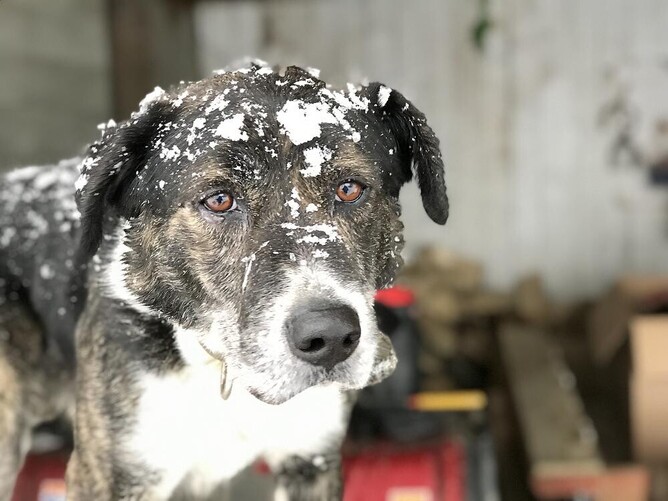Some key points for looking after your team through the winter and having them ready in the spring for another busy season.
With another busy spring looming large in the farming calendar, your working dog team will need to be in optimum condition.
Here is some key nutritional information to help you look after your dogs through the winter months, so they are ready for action when you need them.
How does nutrition affect your working dog?
The dietary proportions of fat, protein and carbohydrate influence fuel selection during exercise.
At moderate levels of exercise, your dog’s muscle cells will use fat (fatty acids) as the preferred energy source. As exercise intensity increases, these cells will also have to start using a greater proportion of the muscle and liver glycogen reserves.
Exhaustion results when muscle stores of glycogen are depleted or hypoglycaemia (low blood glucose) is reached.
Endurance training conditions your dog’s muscle cells to stay in the fat oxidation mode, which results in increased endurance by preserving the muscle glycogen stores for longer during extended periods of work.
The importance of protein
Working dogs have high protein requirements to regenerate muscle and red blood cells.
In a significantly energy depleted dog (when their fat and glycogen stores are used up), more protein will have to be converted to energy, resulting in further depletion of blood proteins and muscle mass.
The incidence of musculoskeletal injuries is significantly higher in working dogs that are fed low protein diets.
Feeding a high quality, high protein diet has been demonstrated to protect those dogs against significant falls in their red blood cell counts (anaemia), as can happen during periods of high workload.
Feeding trials in NZ working dogs have established that dogs working hard on hill country, especially in poor weather, will often have much higher energy and nutrient requirements than their standard maintenance diet could possibly provide.
Tips for food selection
Check the protein source on the bag label.
It may state a high crude protein level, but if it is plant protein, this will have a lower bioavailability (less able to be digested and absorbed) than animal protein, which means that a lower amount is actually available for the dog to use.
Supplement homekill dog tucker with a premium energy dense (smaller volume) dog food.
There are known risks associated with eating raw meat and bones, such as dental damage, intestinal obstructions, gut infections and constipation. T.ovis (sheep measles) is also a risk if meat is not adequately frozen or cooked.
While the combination of meat and a standard biscuit diet may be quite adequate for many dogs doing light work, or during the off season, it is unlikely to provide the correct amounts of protein (amino acids), fatty acids and energy for dogs in a period of heavy work.
For dogs that are already fatigued from working on a winter’s day, rather than sleeping, they will need to spend a considerable amount of time chewing large portions of cold meat, bone and hard biscuits just to consume enough to keep warm and replenish their significant energy and protein demands.
A better strategy would be to supplement homekill dog tucker with a premium energy dense (smaller volume) dog food, rather than the cheaper, cereal-based biscuits.
Ideally, choose a premium quality commercial dry dog food for your team.
In our opinion, feeding this with ad-lib access to clean water best meets the “complete and balanced diet” requirements for your working dog’s health and performance.
In recent years, having seen the benefits for themselves, many farmers have converted to feeding the premium diets that are now available.
Timing of feeding and exercise
There is strong evidence that feeding dogs within two hours after their day's work promotes muscle recovery, with a more rapid and complete replenishment of glycogen stores and the optimal uptake of protein to build and repair muscle cells.
So, kennel and feed them before you go in for your own evening meal.
Although it is not ideal to feed dogs close to the time of working, for some dogs that don’t eat well or struggle to maintain condition and stamina through periods of heavy exercise, a workable recommendation is to feed a small meal (one cup) of an energy dense diet at least two hours before work and then the balance of the ration within two hours of finishing work.
This protocol would also be recommended for huntaway dogs that have had problems with bloating or have previously had a twisted stomach (GDV), so as to reduce the volume of food given per feed. A surgical procedure called a prophylactic gastropexy can also be considered for such dogs to reduce the chance of a GDV happening.
Top tips to maintain healthy dogs over winter
Feed your dogs high quality food, even on days they have not worked, to maintain heat production, energy reserves and tissue repair;
Ensure that drinking water is always provided and accessible during periods of work and when kennelled (stable bowls, not iced over);
Check that their kennels are well positioned and insulated. Dogs that are too hot or cold will have to burn more energy to maintain normal body temperature, will be stressed and will have less effective sleep patterns;
The provision of bedding can be difficult for a dog that destroys it, but dog coats at night are usually tolerated and can also be used through the winter season to reduce windchill when being transported on farm;
Maintain standard control treatments for internal and external parasites for optimal health and food utilisation.

